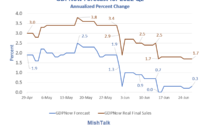Yen at 150 May Risk Rerun of Asia Financial Crisis, O’Neill Says
(Bloomberg) — The yen’s slide may spark turmoil on the scale of the 1997 Asian Financial Crisis if it declines as far as 150 per dollar, veteran economist Jim O’Neill said.
Most Read from Bloomberg
A slump of that magnitude may convince China to intervene in the currency market to protect its own flagging economy and it would be perfectly rational for it to do so, he said in an interview last month that he affirmed on Thursday.
“If the yen keeps weakening, China will see this as unfair competitive advantage so the parallels to the Asian Financial Crisis are perfectly obviously,” said O’Neill, who was chief currency economist at Goldman Sachs at the time of the crisis, and is now senior adviser to Chatham House. “China would not want this devaluing of currencies to threaten their economy.”
The yen’s depreciation path, though, could be nearing its end, he added via email, “because it doesn’t suit Japan or the rest of the world for it to weaken further.” The yen has already slumped about 14% this year and declined to 134.56 on Thursday, the weakest level since April 2002. Its weakness has been driven by divergence between the dovish Bank of Japan and hawkishness at other central banks.
“If we see the Bank of Japan sticking to yield curve control and we see bond yields continuing to rise in the US, this kind of momentum and the fallout could create real problems in Beijing,” O’Neill said.
During the 1997 crisis, countries including the US and Japan urged China not to devalue the yuan due to concern that may lead to a chain reaction of currency weakness. The Asian nation’s ultimate decision to maintain the yuan’s peg helped put a floor under the region.
China played a role in “saving the region” and its level of influence may be even bigger now, said O’Neill, who coined the term BRICs to refer jointly to Brazil, Russia, India and China.
The Chinese government’s commitment to maintaining zero Covid cases through extensive lockdowns in major cities has fueled investor concern the country will fail to meet its growth target this year. Policy makers have introduced fiscal stimulus as concern over capital outflows is seen holding them back from cutting interest rates.
“The yuan is reflecting the rigid stance on Zero Covid, almost like a deliberate policy-induced slowdown; in other parts of the world this is being done on inflation policy concerns but in China it feels like blind faith,” O’Neill said.
The onshore yuan weakened almost 1% in May after sinking more than 4% in April, the biggest monthly decline on record based on data compiled by Bloomberg.
The yen retraced some of its losses on Thursday, rising 0.3% versus the dollar, but many predict further losses if the BOJ maintains its dovish policy settings.
“I can’t see Japan sticking to yield curve control,” O’Neill said. “The whole time spent on quantitative easing in the West is long past its sell-by date. It will be painful for financial markets but it’s the right thing to do.”
(Updates with O’Neill’s latest comments in paragraph 4.)
Most Read from Bloomberg Businessweek
©2022 Bloomberg L.P.
[ad_2]
Source link


